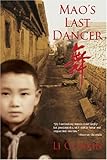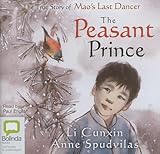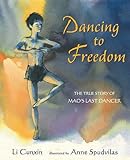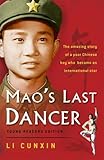Mao’s Last Dancer
At age eleven Li Cunxin’s life was changed when a delegation from Madame Mao’s Beijing Dance Academy selected him to be taken from his home, a village near the city of Qingdao in northern China, and brought to Beijing to study ballet. In 1979 at age 18 he was selected to perform with the Houston Ballet as part of a cultural exchange. After falling in love with both America and an American woman, Li defected to the United States, and rose to fame as one of the world’s ballet stars.
Li Cunxin (pronounced Lee Schwin Sing), performed with Houston Ballet for sixteen years and in 1995 became a principal artist with the Australian Ballet. In 1999 he retired from ballet, supporting his wife and their three children as a stockbroker. In 2003 his autobiography, Mao’s Last Dancer, was published and became an instant success, remaining on Australia’s bestseller list for over a year and a half.

In 2004, Houston Dance Critic Molly Glentzer in her review of the book for Dance Magazine stated, “Li’s tenacity is an inspiring lesson to any reader, dancer or not. It’s the stuff of which great movies are made. Expect this one soon, and bring Kleenex. But read the book first.” A handful of years later, Li’s story is now a motion picture. It has already done well in Australia but unfortunately distribution in the U.S. is still speculative. The film is directed by Bruce Beresford (Driving Miss Daisy), written by Jan Sardi (Shine, The Notebook), and choreographed by Graeme Murphy and his creative associate and partner, Janet Vernon.
See also the book review at Ballet.co
Stars of the Film
Though the production team is largely Australian, the filmmakers of course had to look worldwide for the right cast. The movie’s plot spans several years, requiring not one but three actors to play Li Cuxnin as a boy, a teen, and as an adult. The Birmingham Royal Ballet’s Chi Cao was selected to play the adult Cuxnin. His shared history of having trained at the Beijing Dance Academy and known for his virtuoso performances, Cao was an natural choice for the role.
Cao appeared last month as a guest artist with the Houston Ballet, playing the Nutcracker Prince for four performances in their annual production. HB blogged about it here and Cao talked with Molly Glentzer for the Houston Chronicle about his film debut.
Other notable actors in the film include Amanda Schull (Center Stage) and Bruce Greenwood as Ben Stevenson (Captain Christopher Pike in last year’s Star Trek). You can see interviews with more of the cast and crew at the film’s website and YouTube channel. Read a review of Mao’s Last Dancer via the Hollywood Reporter [link].
Classroom Applications


Li Cuxnin’s story is available in multiple formats. The picture book version “focuses on two stories from Li’s childhood that hold a particular appeal to young children – tying wishes to a kite and a fable told to a young Li by his father of a frog in a well. Both stories illustrate how as a child Li longed for a life away from the hardship of his village.”
[Read more at Suite101: The Autobiography of Li Cunxin: Book Review of Mao’s Last Dancer and The Peasant Prince].

Cuxnin’s autobiography Mao’s Last Dancer is also available in a Young Reader edition for teens. Teachers might use any of this literature to explore movement or develop choreography with students. Below are a few of the major themes presented in these stories about Cuxnin’s life. They might be summed up and explored as follows:
- Overcoming Hardship
- Challenge students with a difficult phrase or combination. Reflect on Li’s perseverance despite hardship and ask students to come up with a plan (see this post on goal-setting with dance students) for improving or learning this combination in a way that addresses both the physical and mental (or emotional) battles that must be overcome.
- Oppression vs. Freedom
- Improv or create a movement study of bound versus free flow in movement.
- Chinese Culture and History
- Research Chinese Dance and the influence of ballet on the art form. View video or read about the Chinese Cultural Revolution. You may find these teacher’s notes from Penguin Books helpful [download the pdf]. Choose movement or music that reflects your findings.
- Adapting to Change
- Coming to Texas in the United States from China was a big transition. Have students create two lists of adjectives – one describing Li’s life in China, the other his life in America. Have them improvise or develop movement or actions that build upon these lists.
What are some other ways you might tie-in the books or movie in your classes?
Have you seen the movie? What did you think?
Nichelle Suzanne is a writer specializing in dance and online content. She is also a dance instructor with over 20 years experience teaching in dance studios, community programs, and colleges. She began Dance Advantage in 2008, equipped with a passion for movement education and an intuitive sense that a blog could bring dancers together. As a Houston-based dance writer, Nichelle covers dance performance for Dance Source Houston, Arts+Culture Texas, and other publications. She is a leader in social media within the dance community and has presented on blogging for dance organizations, including Dance/USA. Nichelle provides web consulting and writing services for dancers, dance schools and studios, and those beyond the dance world. Read Nichelle’s posts.

![Reblog this post [with Zemanta]](https://img.zemanta.com/reblog_e.png?x-id=b0ef5ca8-adce-41ae-aeae-b3fcabffc8cb)
